m Text replacement - ""," to ","" |
|||
| (158 intermediate revisions by 25 users not shown) | |||
| Line 1: | Line 1: | ||
Technologies such as '''computers''' have been mostly bane and less of a blessing to the Colonials of the [[Twelve Colonies]], despite the obvious conveniences that technology brings. It was computer technology that led to the creation of the [[Cylons (RDM)|Cylons]] for household to warfare use. These intelligent machines rebelled. To counter their creation's ability to hack into computers, the Colonial defenses, particularly the [[Galactica type battlestar|first battlestars]], used computers but did not network them to all but eliminate Cylon infiltration. | {{Disline|For computing depicted in ''[[Caprica (series){{!}}Caprica]]'', see: [[Computers in the Caprica Series{{!}}Computers in the ''Caprica'' Series]].}}{{RDM science series}}Technologies such as '''computers''' have been mostly bane and less of a blessing to the Colonials of the [[The Twelve Colonies of Kobol |Twelve Colonies]], despite the obvious conveniences that technology brings. It was computer technology that led to the creation of the [[Cylons (RDM)|Cylons]] for household to warfare use. These intelligent machines rebelled. To counter their creation's ability to hack into computers, the Colonial defenses, particularly the [[Galactica type battlestar|first battlestars]], used computers but did not network them to all but eliminate Cylon infiltration. | ||
Over 40 years after that first [[Cylon War]] and with the Cylons apparently long gone, the Colonials slowly returned to technological conveniences. When the Cylons began planning a second war against the Colonials, they chose to infiltrate the Colonial military through yet another program installed throughout fighters and battlestars that was designed to add more convenience: the [[Command Navigation Program]]. This program, thanks to [[Cylon | Over 40 years after that first [[Cylon War]] and with the Cylons apparently long gone, the Colonials slowly returned to technological conveniences. When the Cylons began planning a second war against the Colonials, they chose to infiltrate the Colonial military through yet another program installed throughout fighters and battlestars that was designed to add more convenience: the [[Command Navigation Program]]. This program, thanks to [[Humanoid Cylon|Cylon agents disguised as humans]] who infiltrated Colonial life and sought out people who had [[Gaius Baltar|access to Colonial computer defense technologies]], contained a "backdoor" that allow the Cylon forces to damage or disable any Colonial vessel with this program. Only non-networked ships (such as most civilian ships or ''Galactica'' herself) or those with comparatively primitive computers (such as [[Viper (RDM)|the Viper Mark II]]) are all-but-immune to the new Cylon menace. | ||
== | As he tours ''Galactica'', [[Doral]] comments that her computers "hardly deserve the name" {{TRS|Miniseries, Night 1}}. Ronald Moore has stated that the computers are actually less powerful than those of contemporary Earth <ref>{{cite_rdm_podcast|episode=Hero|act=1}}</ref>. | ||
[[Image:Seshalaptop 216 1080i.jpg|thumb|right|300px|A laptop computer {{TRS|Sacrifice}}.]] | |||
==Colonial Civilian and Government Computers== | |||
====[[Colonial Defense Mainframe]]==== | |||
:Not much is known of this system other than its existence and the roles they played in the destruction of the Twelve Colonies. This central computer housed key Colonial Fleet logistical information, such as fleet deployment and tactical plans, and was the central system used by [[Gaius Baltar]] to create and distribute the [[Command Navigation Program]] to all advanced ships and fighters in the Colonial Fleet {{TRS|Miniseries}}. Tampering with the mainframe was considered treason and was punishable by death. It was located within the Ministry of Defense on Caprica {{TRS|Six Degrees of Separation}}, since [[Shelly Godfrey|Number Six]] produced credible-looking footage showing Baltar attaching a bomb to it. | |||
====[[War College|War College Simulator]]==== | |||
''' | :[[Lee Adama]] performed simulations of Cylon attacks in War College to test Colonial defense tactics. One such defense involves the use of [[EMP]] devices to fool Cylon forces into believing a nuclear device detonated where no explosion took place. Adama successfully used the electric pulse generators that were offloaded onto ''[[Colonial Heavy 798]]'' from ''Galactica'' to successfully fool two Cylon Raiders into concluding that their nuclear missile attack on ''Colonial Heavy 798'' was successful, while also disabling the warheads of the missiles aimed at the [[Intersun|starliner]]. Adama was amused that this trick actually worked in reality, for in the War College simulations the Cylons were not fooled and destroyed the Colonial targets anyway {{TRS|Miniseries}}. | ||
====Viper Flight Simulators==== | |||
''' | :''Galactica'' loses many pilots to Cylon attack or accident in the first weeks of exodus from the Colonies. Lieutenant [[Kara Thrace]] is ordered to become flight instructor to train [[nugget]]s as new pilots. Normally, pilots are trained on simulators, presumably on one of the Colonies or a more advanced battlestar, which used complex computers to immerse a trainee into the feel of Viper combat. Unfortunately, ''Galactica'' does not have simulators aboard, so Thrace teaches the new pilots using actual Vipers {{TRS|Act of Contrition}}. Months later, the [[Mercury class battlestar|advanced battlestar]] ''[[Pegasus (RDM)|Pegasus]]'' joins the Fleet. The modern resources of this battlestar include flight simulators. Rookie pilots [[Brent Baxton|BB]] and [[Joseph Clark|Jo-Jo]] arrive on ''Galactica'' to begin their tour after training with these simulators on ''Pegasus'' {{TRS|Scar}}. | ||
: | ====Personal Computers==== | ||
[[Image:Hope.jpg|thumb|left|190px|Colonial computer menu {{TRS|Occupation}}.]] | |||
[[Image:Tablet computer.jpg|thumb|right|[[Gina Inviere]] shows [[Kendra Shaw]] the route to [[CIC]] on ''[[Pegasus (RDM)|Pegasus]]'' {{TRS|Razor}}.]] | |||
:Terrorist [[Sesha Abinell]] uses a personal laptop computer in her quarters as she compiles and gathers information on Cylon and Colonial | :In preparation for converting ''Galactica'' into a museum and education center, then-Secretary of Education [[Laura Roslin]] pleads unsuccessfully to then-Commander [[William Adama]] to allow installation of a network for personal computers to be used for teaching and information by students and visitors {{TRS|Miniseries}}. | ||
:Terrorist [[Sesha Abinell]] uses a personal laptop computer<ref>In an amusing props gaffe, fans of the show may notice that the mouse she used is an actual product manufactured by the Microsoft Corporation, which may mistakenly suggest to fans that Microsoft's sales model truly ''is'' universal.</ref> in her quarters as she compiles and gathers information on Cylon and Colonial conspiracy theories {{TRS|Sacrifice}}. | |||
: Network administrator [[Gina Inviere]] uses a tablet personal computer in her work upgrading ''[[Pegasus (RDM)|Pegasus]]''{{'|s}} computers. Like the other computers on ''Pegasus'', the tablet computer accepts inputs via a touchscreen {{TRS|Razor}}. ''Galactica'' also has older versions of these tablet personal computers, as [[Felix Gaeta]] uses one to diagnose the problem with [[Anastasia Dualla]]'s workstation in CIC {{TRS|Flight of the Phoenix}}. | |||
:Standalone computers are also present in [[sickbay]] and Dr. Baltar's laboratory. | |||
:The [[New Caprica Resistance]] has a computer in its underground tunnels, which is used to communicate with Raptors dispatched by ''Galactica'' ("[[Occupation]]," "[[Precipice]]"). | |||
{{clear}} | |||
====Data discs==== | |||
[[Image:Hexdisk1.jpg|thumb|left|200px|Shelly Godfrey's data disc.]] | |||
[[Image:PegDataDisc2.jpg|thumb|right|200px|The case with data discs received by Gaeta.]] | |||
Data discs<ref>{{bsgwiki term}}</ref> are used to transfer amounts of data between separate computers. | |||
:Both [[Shelly Godfrey]] {{TRS|Six Degrees of Separation}} and [[D'anna Biers]] {{TRS|Final Cut}} use data discs to store video files. Their octagonal form fits with Colonial aesthetics (similar to the cut corners on paper). | |||
:In the [[Pegasus (Extended Version)|extended version]] of "[[Pegasus (episode)|Pegasus]]," Lieutenant Gaeta receives a copy of ''Pegasus'''s digital library on such dics. The case also contains a spindle of round discs. | |||
{{clear}} | |||
====[[Portable library reader|Portable library readers]]==== | |||
[[Image:portable library reader.jpg|thumb|A portable library reader {{TRS|Epiphanies}}.]] | |||
:Portable library readers are more like an hand-held electronic dictionary or encyclopedia. They can likely synchronize data from a personal computer. | |||
{{clear}} | |||
==Basestar Computers== | |||
The Cylon are a cybernetic race. As such, ''everything'' is computer-based by nature. To avoid confusion between differentiation of the cybernetic physiology of the [[humanoid Cylon]], only the non-sentient or quasi-sentient computer systems of the basestar are noted here. | |||
===The Hybrid=== | |||
The [[Hybrid]] is a special variety of non-autonomous [[humanoid Cylon]] that rests in a pool of water near or in a basestar's command and control center. Because of its connection to many, if not all, of the basestar's systems, it in effect ''is'' the basestar. Functions such as [[Cylon Centurion]] and Cylon Raider access and deployment appear to be controlled by the Hybrid, as well as navigation control. Whether there is more than one Hybrid model is unknown. | |||
===The Datastream=== | |||
The [[datastream]] is the central network within a basestar. It appears to use a liquid as a data transmission medium, a storage medium, or both. The datastream is suceptible to corruption by [[Lymphocytic encephalitis|certain organic pathogens]] that can also infect the sentient humanoid Cylons. The liquid also appears as waterfalls and pools within a basestar's command and control center, which may also serve as access nodes<ref> {{callsign|Athena}} instructs a member of the boarding team to place a Colonial data gathering device in one of these pools in "[[A Measure of Salvation]]".</ref> (see ''Data port interfaces'' below). | |||
===Data port interfaces=== | |||
While not computers in themselves, humanoid Cylons, which are more biological than cybernetic, have devised a remarkable manner to interface with computer systems with an optical interface. On a basestar, Cylons can access their datastream by placing their arm on an illuminated panel that's covered by a thin layer of liquid. This activates the [[Cylon data port|data port]], an optical interface incorporated within their arms that's otherwise disguised as ordinary human tissues. These interfaces are transceivers that can also be configured for visual data such as photography. | |||
==Battlestar Computers== | ==Battlestar Computers== | ||
[[Image:Bsgcontrl.jpg|thumb|right|Master systems display on ''Galactica''.]] | |||
A battlestar has several computers dedicated to many critical ship functions. Several specific computers have been mentioned or seen during the series. This list is not inclusive; an [[Galactica type battlestar|original battlestar]] like ''Galactica'' is still a very complex spacecraft. On advanced battlestars such as ''[[Pegasus (RDM)|Pegasus]]'', the highly networked computers theoretically allow the crew to control any system from any location, if one possesses the correct passwords {{TRS|Razor}}. However, it is likely that after the [[Fall of the Twelve Colonies]], ''Pegasus'' is not as strongly networked as before, in order to create similar defenses against Cylon intrusion as its predecessors. | |||
Although the battlestar normally does not have a central computer network in place, ''Galactica'' does possess a [[Wikipedia:Default gateway|gateway]], which, in ''Galactica' | Although the battlestar normally does not have a central computer network in place, ''Galactica'' does possess a [[Wikipedia:Default gateway|gateway]], which, in ''Galactica'''s case, is likely managed within the mainframe itself and not as a larger network topology. The mainframe's normally-isolated gateway can be linked to the other computers (as Gaeta does in "[[Scattered]]"). | ||
===Navigation Computer=== | ===Navigation Computer=== | ||
Also known as the " | [[Image:navcomp_002_720p.jpg|thumb|NAV Computer Display of ''Galactica'' {{TRS|Miniseries}}]] | ||
Also known as the "NAV" or "NAVCON" computer, it tracks the battlestar's position and handles [[Sublight Propulsion|sublight]] travel and [[RCS]] translations. It is very likely that [[DRADIS]] sensor information is obtained and managed by the Navigation Computer then passed on to the [[Tactical Officer]] and the Command & Control Center in the [[CIC]]. | |||
The DRADIS system, while having digital controls, is an analog instrument (utilizing EM radiation), which protects it from direct ''external'' infiltration by Cylon electronic attack. As shown in "[[Flight of the Phoenix]]," the navigation computer hardware, as with practically every other computer system, is subceptible to ''internal'' compromise by Cylon viruses or logic bombs already present in the battlestar's other systems.<ref name="tech5A">"The LAN that Time Forgot," Dr. [[Kevin Grazier]] (the show's science adviser), [http://www.hollywoodnorthreport.com/article.php?Article=2793 BSG Tech Blog], entry 5A, August 8, 2005.</ref> | |||
''Pegasus's'' navigation computer is off-line during the Cylon attack, forcing Admiral Cain to order a risky [[blind jump]] without any navigational data fed to the FTL drive {{TRS|Razor}}. | |||
{{clear}} | |||
[[Image:ftlcomp_217_1080i.jpg|thumb|FTL Systems Display of ''Pegasus'' {{TRS|The Captain's Hand}}]] | |||
===FTL Computer=== | ===FTL Computer=== | ||
The FTL computer manages the complex calculations necessary for an [[FTL]] | The FTL computer manages the complex calculations necessary for an [[FTL]] jump. Information for these jumps on a more [[Mercury class battlestar|advanced battlestar]] such as ''Pegasus'' are probably transmitted from the Navigation Computer by the battlestar's network. | ||
On ''Galactica'', however, the FTL computer receives the spatial coordinates manually from the [[Tactical Officer]] or its Communications Officer. The FTL | On ''Galactica'', however, the FTL computer receives the spatial coordinates manually from the [[Tactical Officer]] or its Communications Officer. The FTL computer also manages the star fixes of the jump coordinates to compensate for inertial drift that naturally occurs over time. The Tactical Officer generates a series of emergency jump coordinates for the [[The Fleet (RDM)|Fleet]] with the FTL computer. This information is relayed to other ships regularly. It is likely that the [[flight pod]]s are also controlled through the FTL computer as they must be retracted prior to a jump.<ref name="scattered">One of Gaeta's responsibilities is to monitor DRADIS contacts. To navigate, a battlestar must use some way to determine its location relative to other objects, so the Navigation and DRADIS connection must exist.</ref> | ||
{{clear}} | |||
[[Image:PegasusDamageDisplay2.jpg|thumb|Damage Control display of ''Pegasus'' {{TRS|The Captain's Hand}}]] | |||
===Damage Control Computer=== | ===Damage Control Computer=== | ||
The Damage Control computer relays information to the CIC on malfunctioning or damaged areas of the battlestar, presumably from various sensors throughout the ship. It also has access to radiation sensors in the event of nuclear attack to warn against dangerous radiation levels that could harm the crew.<ref name="miniseries2">While Colonel Tigh was on a handset ordering the retraction of the pods as the battlestar began its escape from Ragnar Anchorage, many events within the ship must be coordinated (bulkheads closing, motors for the pod movement activated, etc.) While there was likely a person in CIC or elsewhere that flips a switch or types in a computer command, there must still be a computer used to coordinate these events as they are too many to manage in a limited amount of time {{TRS|Miniseries}}.</ref> The DC computer's function can be compromised by a hostile force through places such as [[Aft Damage Control]], as was threatened in "[[Valley of Darkness]]". If these locations are compromised, the computer's safeties can be overridden and various life-support controls, such as bulkheads and atmospheric controls, could be altered, venting the ship's air (and crew) into space. | |||
{{clear}} | |||
The Damage Control computer relays information to the CIC on malfunctioning or damaged areas of the battlestar, presumably from various sensors throughout the ship. It also has access to radiation sensors in the event of nuclear attack to warn against dangerous radiation levels that could harm the crew.{{ref | |||
[[Image:Maingunredlight_101_1080i.jpg|thumb|Fire Control Display Panel {{TRS|33}}]] | |||
===Fire Control Computer=== | ===Fire Control Computer=== | ||
The Fire Control computer manages a battlestar's primary offensive weapons, the central flak turret and smaller port and starboard turrets along the length of each side of the ship. It is presumed that the Fire Control computers report to crewmembers responsible for the upkeep of ammunition on the guns when to reload an particular turret. The Fire Control computer can target individual bogeys with the flak turret guns, which, in tandem with the smaller turrets, make even ''Galactica'', an old original battlestar from the first [[Cylon War]], a formidable foe to encounter.{{ | The Fire Control computer manages a battlestar's primary offensive weapons, the central flak turret and smaller port and starboard turrets along the length of each side of the ship. It is presumed that the Fire Control computers report to crewmembers responsible for the upkeep of ammunition on the guns when to reload an particular turret. The Fire Control computer can target individual bogeys with the flak turret guns, which, in tandem with the smaller turrets, make even ''Galactica'', an old original battlestar from the first [[Cylon War]], a formidable foe to encounter. Like the DC computer, there are control rooms on ''Galactica'' where the ship's computerized gun control can be overriden.<ref name="miniseries">''Galactica'''s flak turret guns are seen directly targeting specific missiles during the [[Battle of Ragnar Anchorage]] {{TRS|Miniseries}}.</ref> | ||
===Mainframe Computer=== | ===Mainframe Computer=== | ||
This computer likely manages secondary functions of the ship, such as communications. The mainframe likely provides extra calculating power for other ship tasks when required, and may also serve as the ship's library for tactical information.{{ | This computer likely manages secondary functions of the ship, such as communications. The mainframe likely provides extra calculating power for other ship tasks when required, and may also serve as the ship's library for tactical information.<ref name="phe">[[Sharon Agathon|Caprica-Valerii]]: "Mr. Gaeta, can you set me up with a fiber-optic com link? I need broadcast to all frequencies and direct link to the mainframe." {{TRS|Flight of the Phoenix}}</ref> Of all the computers on ''Galactica'', this computer is likely very resistant by design to infiltration since it controls communication traffic (and thus is accessible to Cylon external intrusion by [[wireless]]). The mainframe likely possesses a basic gateway, but, per ''Galactica'''s no-networks edict, it is typically unused. | ||
The communications elements of the mainframe, while having digital controls, are analog instruments, which make them highly resistant to external Cylon electronic attack as they do not transfer digital signals. As with other battlestar systems, the mainframe hardware remains susceptible to internal Cylon electronic attacks (viruses and logic bombs that infect and transfer from other systems).<ref name="tech5A"/> | |||
===Environmental Computer=== | |||
This computer is mentioned briefly by Lt. Gaeta after an incident where the effects of a Cylon logic bomb confused the environmental computer into venting the firing range room of its pressure, almost killing [[Kara Thrace]], [[Lee Adama]] and [[Brendan Costanza]] {{TRS|Flight of the Phoenix}}. | |||
The environmental computer is likely connected to the nearly one-dozen carbon dioxide air scrubbers throughout ''Galactica'', which remove the excess levels of the gas before it reaches toxic levels {{TRS|Final Cut}}. | |||
==Avionics== | ==Avionics== | ||
:''The computer systems found on fighters and support aircraft of a capital ship are generally described by the term ''[[Wikipedia:Avionics|avionics]]'' (AVIation electrONICS). In the world of ''Battlestar Galactica'', aircraft terminology is intermixed with spacecraft terminology--note the use of "[[CAG]]" and Commander Adama's use of the word "planes" to Chief [[Galen Tyrol]] to describe the Viper space fighter | :''The computer systems found on fighters and support aircraft of a capital ship are generally described by the term ''[[Wikipedia:Avionics|avionics]]'' (AVIation electrONICS). In the world of ''Battlestar Galactica'', aircraft terminology is intermixed with spacecraft terminology--note the use of "[[CAG]]" and Commander Adama's use of the word "planes" to Chief [[Galen Tyrol]] to describe the Viper space fighter {{TRS|Litmus}}. As the term "avionics" is used in the episode "[[Flesh and Bone]]" to describe the flight electronics on the captured [[Raider]], despite its aeronautical connotation, it will be used here.'' | ||
===Colonial Avionics=== | ===Colonial Avionics=== | ||
[[ | The [[Colonial Fleet (TRS)|Colonial Fleet]] relied initially on primitive, hard-wired avionics in its early fighters, but later reverted to more "[[Wikipedia:Fly by wire|fly-by-wire]]" technologies, one of which sealed the doom of billions of citizens. | ||
====Vipers and Raptors==== | |||
[[Image:Vipermk2interior 104 1080i.jpg|left|thumb|200px|A view of the manual "8-ball" landing software on a Viper Mk. II.]] | |||
[[Image:Vipermk2interior3 104 1080i.jpg|right|thumb|200px|A view of a Mk. II secondary display below the primary display, currently using [[DRADIS]].]] | [[Image:Vipermk2interior3 104 1080i.jpg|right|thumb|200px|A view of a Mk. II secondary display below the primary display, currently using [[DRADIS]].]] | ||
The '''avionics''' found on modern [[Viper (RDM)|Viper]]s and [[Raptor]]s are complex systems that combine fly-by-wire technology with computer systems. | |||
In the case of Raptors, [[datacord]] is used for networking subsystems. This wiring makes Raptors more radiation-hardened and thus useful in high-radiation conditions <ref>Raptors are used as pilot ships in the episode "[[The Passage]]".</ref>. | |||
{{clear}}[[Image:ViperMk2Avionics.jpg|left|thumb|200px|Viper Mk. II cockpit avionics, resistant to Cylon infiltration.]] | |||
The older and generally-obsolete [[Viper Mark II]] fighters have a more primitive avionics package, but unlike [[CNP]]-equipped [[Viper Mark VII]]s and Raptors, these old-style Viper systems (a design similar to that used in the [[Cylon War]]) appear to combine hydraulics <ref>Note the leaking fluid on [[Viper 289]] in the episode "[[Flight of the Phoenix]]," strongly suggesting a hydraulic flight control system on these fighters.</ref> with a basic computer and [[DRADIS]] subsystem that is effectively immune from Cylon electronic counterattack. | |||
Both Vipers are equipped with a multi-functional display that can can be set to various modes, such as DRADIS, navigation, engines, system status and weapons. | |||
{{clear}} | |||
The flight systems of these systems also likely include these components, which vary in availability or degrees of complexity depending on the craft's age or purpose: | |||
* A non-directional medium-range [[wireless]] communications for ship-to-ship and ship-to-planet contact | * A non-directional medium-range [[wireless]] communications for ship-to-ship and ship-to-planet contact | ||
* [[DRADIS]] hardware for enemy targeting, squadron formation flight maneuvers, | * [[DRADIS]] hardware for enemy targeting, squadron formation flight maneuvers, etc. | ||
* A Colonial transponder for [[IFF]] "friend or foe" identification | * A Colonial transponder for [[IFF]] "friend or foe" identification | ||
* Stellar positioning system for proper [[Sublight Propulsion|sublight]] or [[FTL]] | * Stellar positioning system for proper [[Sublight Propulsion|sublight]] or [[FTL]] navigation | ||
** Larger craft such as Raptors can manage FTL jumps and so come equipped with more advanced avionics to handle jump computations | |||
* Instrument Landing Systems (ILS), an automatic ("hands-off") landing system guidance package | * Instrument Landing Systems (ILS), an automatic ("hands-off") landing system guidance package | ||
{{clear}} | |||
[[Image:ViperMk7Avionics.jpg | [[Image:ViperMk7Avionics.jpg|thumb|200px|Viper Mk. VII cockpit avionics, vulnerable if the [[CNP]] is installed.]] | ||
====Vulnerabilities==== | |||
In the case of modern (pre-[[Fall of the Twelve Colonies|holocaust]]) spacecraft, many of these systems were likely tied into (either as a software or firmware component) the tainted [[Command Navigation Program]]. Evidence for this is strong as [[Jackson Spencer]]'s Mark VII Viper loses power, communications, flight control, DRADIS, and apparently ejection control after Cylon fighters "rooted," or counter-commanded his Viper to shut down, thanks to the backdoors installed in these modern avionics packages {{TRS|Miniseries}}. | |||
''Galactica'' prohibits computerized landings, so all pilots perform [[Hands-on Approach|manual approach and landings]] in [[Combat landing|non-combat situations]]. No information has been given in the series if Mark II Vipers are capable of auto-landings in the manner that Mark VIIs demonstrate {{TRS|Miniseries}}. | |||
{{clear}} | |||
===Cylon Avionics=== | |||
''Galactica'' prohibits computerized landings, so all pilots perform [[Hands-on Approach|manual approach and landings]] in [[Combat landing|non-combat | |||
Cylon avionics contain biological elements, some of which include or are interfaced with quasi-sentient elements. | |||
=== | ====Raiders==== | ||
[[Cylon Raiders]] contain some level of avionics that co-exist amidst the biological components that form the "pilot" within the fuselage of the fighter. Kara Thrace identifies the mechanical linkage within a captured fighter, and [[Galen Tyrol]]'s team identifies the fire control, navigation, and FTL drive components in addition to an actual avionics package {{TRS|Flesh and Bone}}. ''Galactica'' flight crews later rigged a flight control console that mated with the Raider's avionics for human readability. | |||
The Cylons moved to biomechanical pilots rather than using Centurions or other robotic pilot for three probable reasons: | |||
The Cylons | # The Cylons' monotheistic belief in [[God (RDM)|God]] and their belief in procreation (machines cannot procreate, but living organisms can) suggest that they believe a biological pilot would be more effective. A Raider pilot is programmed with a basic personality akin to a predatory animal. Unlike the logic of a Centurion, a Raider pilot is capable of improvements in its programming--it can learn and anticipate changes in battle ("[[Six Degrees of Separation]]," "[[Scar]]"). | ||
# Colonial forces may attempt to use [[ECM|electronic countermeasures]] that could affect the performance or operation of a fully-mechanical Cylon Raider or a craft piloted by autonomous [[Cylon Centurion]]s. Biological pilots cannot be easily disabled by ECM. | |||
# A Raider's personality, like a [[humanoid Cylon]], is downloadable and transferable should the fighter be destroyed. This provides the Cylons a dramatic tactical advantage over the Colonials since the knowledge of a Raider isn't lost in death, allowing it to improve its fighting as well as allowing riskier tactics (such as ramming) without permanent loss of self, provided a [[Resurrection Ship]] or the [[Cylon homeworld]] is sufficiently close to retrieve a signal {{TRS|Scar}}. | |||
Raiders are capable of independent thought, which is demonstrated during the [[Battle of the Ionian Nebula]], where one identifies [[Samuel Anders]] as a humanoid Cylon. This causes all other Raiders to break off the attack and forces the Cylon fleet to retreat {{TRS|He That Believeth in Me}}. | |||
====Heavy Raider==== | |||
The interior of a [[Heavy Raider]], or its cockpit, have not been revealed. While no information is available as to the nature of their avionics and piloting requirements, events suggest that the Heavy Raider is not an autonomous or quasi-autonomous vehicle ([[Fragged]]," "[[The Farm]]," "[[Home, Part I]]") . | |||
====Vulnerabilities==== | |||
Cylon spacecraft avionics can be affected by infiltration with the right methods. The cooperative Cylon infiltrator copy of [[Sharon Agathon|Sharon Valerii]] used herself as a [[backdoor]] to send a version of a Cylon virus to shut down power to a massive Cylon fleet en route to attack ''Galactica'' {{TRS|Flight of the Phoenix}}. It was not shown whether the biologics of the Cylon Raiders are themselves affected by this unexpected infiltration from Valerii. | |||
The organic nature of most Cylon cybernetics is also susceptible to [[Lymphocytic encephalitis|classic human pathogens]], which can cause massive and catastrophic system failure. The infection that caused a basestar to succumb {{TRS|Torn}}, according to other Cylons investigating the incident, has a bioelectric nature that could cause it to behave more like programming, allowing the [[Resurrection (RDM)|downloaded personalities]] of infected agents to infect the entire Cylon race via the [[Resurrection Ship]]. | |||
==Computer History== | |||
:''For more information on the use of Colonial computers in the series, see [[Colonial Computer History]].'' | |||
== Notes == | |||
*Colonial aesthetics often eschew right angles, instead using [[Arts and Literature of the Twelve Colonies#Octagons|octagons]]. Many computer programs also follow this design by having windows, menus or buttons with angled corners. | |||
== | ==References== | ||
{{reflist}} | |||
[[Category:A to Z]] | [[Category:A to Z]] | ||
[[Category:RDM]] | [[Category:RDM]] | ||
[[Category: Cylons (RDM)]] | |||
[[Category:Descriptive terms]] | |||
[[Category:Technology]] | [[Category:Technology]] | ||
[[Category:Technology (RDM)]] | |||
[[Category:Terminology]] | [[Category:Terminology]] | ||
[[Category:Terminology (RDM)]] | |||
{{featured article}} | |||
{{quality candidate}} | |||
Latest revision as of 22:12, 20 February 2024
For computing depicted in Caprica, see: Computers in the Caprica Series.
|
| An article from |
Technologies such as computers have been mostly bane and less of a blessing to the Colonials of the Twelve Colonies, despite the obvious conveniences that technology brings. It was computer technology that led to the creation of the Cylons for household to warfare use. These intelligent machines rebelled. To counter their creation's ability to hack into computers, the Colonial defenses, particularly the first battlestars, used computers but did not network them to all but eliminate Cylon infiltration.
Over 40 years after that first Cylon War and with the Cylons apparently long gone, the Colonials slowly returned to technological conveniences. When the Cylons began planning a second war against the Colonials, they chose to infiltrate the Colonial military through yet another program installed throughout fighters and battlestars that was designed to add more convenience: the Command Navigation Program. This program, thanks to Cylon agents disguised as humans who infiltrated Colonial life and sought out people who had access to Colonial computer defense technologies, contained a "backdoor" that allow the Cylon forces to damage or disable any Colonial vessel with this program. Only non-networked ships (such as most civilian ships or Galactica herself) or those with comparatively primitive computers (such as the Viper Mark II) are all-but-immune to the new Cylon menace.
As he tours Galactica, Doral comments that her computers "hardly deserve the name" (TRS: "Miniseries, Night 1"). Ronald Moore has stated that the computers are actually less powerful than those of contemporary Earth [1].
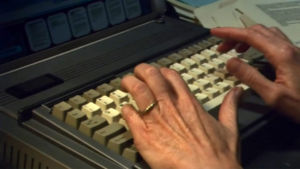
Colonial Civilian and Government Computers[edit]
Colonial Defense Mainframe[edit]
- Not much is known of this system other than its existence and the roles they played in the destruction of the Twelve Colonies. This central computer housed key Colonial Fleet logistical information, such as fleet deployment and tactical plans, and was the central system used by Gaius Baltar to create and distribute the Command Navigation Program to all advanced ships and fighters in the Colonial Fleet (TRS: "Miniseries"). Tampering with the mainframe was considered treason and was punishable by death. It was located within the Ministry of Defense on Caprica (TRS: "Six Degrees of Separation"), since Number Six produced credible-looking footage showing Baltar attaching a bomb to it.
War College Simulator[edit]
- Lee Adama performed simulations of Cylon attacks in War College to test Colonial defense tactics. One such defense involves the use of EMP devices to fool Cylon forces into believing a nuclear device detonated where no explosion took place. Adama successfully used the electric pulse generators that were offloaded onto Colonial Heavy 798 from Galactica to successfully fool two Cylon Raiders into concluding that their nuclear missile attack on Colonial Heavy 798 was successful, while also disabling the warheads of the missiles aimed at the starliner. Adama was amused that this trick actually worked in reality, for in the War College simulations the Cylons were not fooled and destroyed the Colonial targets anyway (TRS: "Miniseries").
Viper Flight Simulators[edit]
- Galactica loses many pilots to Cylon attack or accident in the first weeks of exodus from the Colonies. Lieutenant Kara Thrace is ordered to become flight instructor to train nuggets as new pilots. Normally, pilots are trained on simulators, presumably on one of the Colonies or a more advanced battlestar, which used complex computers to immerse a trainee into the feel of Viper combat. Unfortunately, Galactica does not have simulators aboard, so Thrace teaches the new pilots using actual Vipers (TRS: "Act of Contrition"). Months later, the advanced battlestar Pegasus joins the Fleet. The modern resources of this battlestar include flight simulators. Rookie pilots BB and Jo-Jo arrive on Galactica to begin their tour after training with these simulators on Pegasus (TRS: "Scar").
Personal Computers[edit]
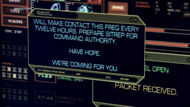
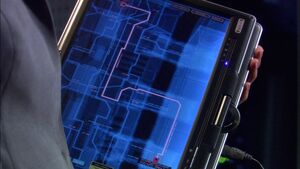
- In preparation for converting Galactica into a museum and education center, then-Secretary of Education Laura Roslin pleads unsuccessfully to then-Commander William Adama to allow installation of a network for personal computers to be used for teaching and information by students and visitors (TRS: "Miniseries").
- Terrorist Sesha Abinell uses a personal laptop computer[2] in her quarters as she compiles and gathers information on Cylon and Colonial conspiracy theories (TRS: "Sacrifice").
- Network administrator Gina Inviere uses a tablet personal computer in her work upgrading Pegasus's computers. Like the other computers on Pegasus, the tablet computer accepts inputs via a touchscreen (TRS: "Razor"). Galactica also has older versions of these tablet personal computers, as Felix Gaeta uses one to diagnose the problem with Anastasia Dualla's workstation in CIC (TRS: "Flight of the Phoenix").
- Standalone computers are also present in sickbay and Dr. Baltar's laboratory.
- The New Caprica Resistance has a computer in its underground tunnels, which is used to communicate with Raptors dispatched by Galactica ("Occupation," "Precipice").
Data discs[edit]
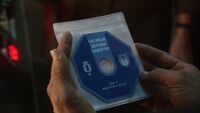
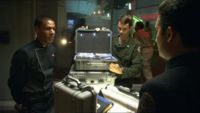
Data discs[3] are used to transfer amounts of data between separate computers.
- Both Shelly Godfrey (TRS: "Six Degrees of Separation") and D'anna Biers (TRS: "Final Cut") use data discs to store video files. Their octagonal form fits with Colonial aesthetics (similar to the cut corners on paper).
- In the extended version of "Pegasus," Lieutenant Gaeta receives a copy of Pegasus's digital library on such dics. The case also contains a spindle of round discs.
Portable library readers[edit]
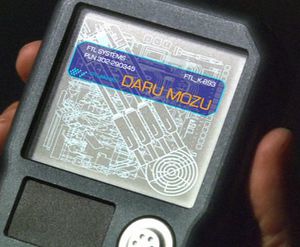
- Portable library readers are more like an hand-held electronic dictionary or encyclopedia. They can likely synchronize data from a personal computer.
Basestar Computers[edit]
The Cylon are a cybernetic race. As such, everything is computer-based by nature. To avoid confusion between differentiation of the cybernetic physiology of the humanoid Cylon, only the non-sentient or quasi-sentient computer systems of the basestar are noted here.
The Hybrid[edit]
The Hybrid is a special variety of non-autonomous humanoid Cylon that rests in a pool of water near or in a basestar's command and control center. Because of its connection to many, if not all, of the basestar's systems, it in effect is the basestar. Functions such as Cylon Centurion and Cylon Raider access and deployment appear to be controlled by the Hybrid, as well as navigation control. Whether there is more than one Hybrid model is unknown.
The Datastream[edit]
The datastream is the central network within a basestar. It appears to use a liquid as a data transmission medium, a storage medium, or both. The datastream is suceptible to corruption by certain organic pathogens that can also infect the sentient humanoid Cylons. The liquid also appears as waterfalls and pools within a basestar's command and control center, which may also serve as access nodes[4] (see Data port interfaces below).
Data port interfaces[edit]
While not computers in themselves, humanoid Cylons, which are more biological than cybernetic, have devised a remarkable manner to interface with computer systems with an optical interface. On a basestar, Cylons can access their datastream by placing their arm on an illuminated panel that's covered by a thin layer of liquid. This activates the data port, an optical interface incorporated within their arms that's otherwise disguised as ordinary human tissues. These interfaces are transceivers that can also be configured for visual data such as photography.
Battlestar Computers[edit]
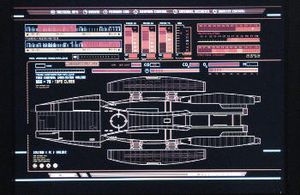
A battlestar has several computers dedicated to many critical ship functions. Several specific computers have been mentioned or seen during the series. This list is not inclusive; an original battlestar like Galactica is still a very complex spacecraft. On advanced battlestars such as Pegasus, the highly networked computers theoretically allow the crew to control any system from any location, if one possesses the correct passwords (TRS: "Razor"). However, it is likely that after the Fall of the Twelve Colonies, Pegasus is not as strongly networked as before, in order to create similar defenses against Cylon intrusion as its predecessors.
Although the battlestar normally does not have a central computer network in place, Galactica does possess a gateway, which, in Galactica's case, is likely managed within the mainframe itself and not as a larger network topology. The mainframe's normally-isolated gateway can be linked to the other computers (as Gaeta does in "Scattered").
[edit]

Also known as the "NAV" or "NAVCON" computer, it tracks the battlestar's position and handles sublight travel and RCS translations. It is very likely that DRADIS sensor information is obtained and managed by the Navigation Computer then passed on to the Tactical Officer and the Command & Control Center in the CIC.
The DRADIS system, while having digital controls, is an analog instrument (utilizing EM radiation), which protects it from direct external infiltration by Cylon electronic attack. As shown in "Flight of the Phoenix," the navigation computer hardware, as with practically every other computer system, is subceptible to internal compromise by Cylon viruses or logic bombs already present in the battlestar's other systems.[5]
Pegasus's navigation computer is off-line during the Cylon attack, forcing Admiral Cain to order a risky blind jump without any navigational data fed to the FTL drive (TRS: "Razor").
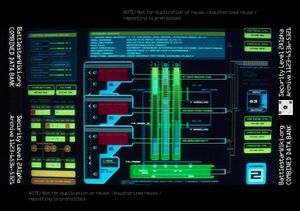
FTL Computer[edit]
The FTL computer manages the complex calculations necessary for an FTL jump. Information for these jumps on a more advanced battlestar such as Pegasus are probably transmitted from the Navigation Computer by the battlestar's network.
On Galactica, however, the FTL computer receives the spatial coordinates manually from the Tactical Officer or its Communications Officer. The FTL computer also manages the star fixes of the jump coordinates to compensate for inertial drift that naturally occurs over time. The Tactical Officer generates a series of emergency jump coordinates for the Fleet with the FTL computer. This information is relayed to other ships regularly. It is likely that the flight pods are also controlled through the FTL computer as they must be retracted prior to a jump.[6]
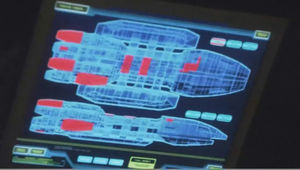
Damage Control Computer[edit]
The Damage Control computer relays information to the CIC on malfunctioning or damaged areas of the battlestar, presumably from various sensors throughout the ship. It also has access to radiation sensors in the event of nuclear attack to warn against dangerous radiation levels that could harm the crew.[7] The DC computer's function can be compromised by a hostile force through places such as Aft Damage Control, as was threatened in "Valley of Darkness". If these locations are compromised, the computer's safeties can be overridden and various life-support controls, such as bulkheads and atmospheric controls, could be altered, venting the ship's air (and crew) into space.
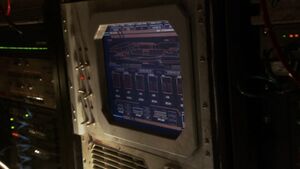
Fire Control Computer[edit]
The Fire Control computer manages a battlestar's primary offensive weapons, the central flak turret and smaller port and starboard turrets along the length of each side of the ship. It is presumed that the Fire Control computers report to crewmembers responsible for the upkeep of ammunition on the guns when to reload an particular turret. The Fire Control computer can target individual bogeys with the flak turret guns, which, in tandem with the smaller turrets, make even Galactica, an old original battlestar from the first Cylon War, a formidable foe to encounter. Like the DC computer, there are control rooms on Galactica where the ship's computerized gun control can be overriden.[8]
Mainframe Computer[edit]
This computer likely manages secondary functions of the ship, such as communications. The mainframe likely provides extra calculating power for other ship tasks when required, and may also serve as the ship's library for tactical information.[9] Of all the computers on Galactica, this computer is likely very resistant by design to infiltration since it controls communication traffic (and thus is accessible to Cylon external intrusion by wireless). The mainframe likely possesses a basic gateway, but, per Galactica's no-networks edict, it is typically unused.
The communications elements of the mainframe, while having digital controls, are analog instruments, which make them highly resistant to external Cylon electronic attack as they do not transfer digital signals. As with other battlestar systems, the mainframe hardware remains susceptible to internal Cylon electronic attacks (viruses and logic bombs that infect and transfer from other systems).[5]
Environmental Computer[edit]
This computer is mentioned briefly by Lt. Gaeta after an incident where the effects of a Cylon logic bomb confused the environmental computer into venting the firing range room of its pressure, almost killing Kara Thrace, Lee Adama and Brendan Costanza (TRS: "Flight of the Phoenix").
The environmental computer is likely connected to the nearly one-dozen carbon dioxide air scrubbers throughout Galactica, which remove the excess levels of the gas before it reaches toxic levels (TRS: "Final Cut").
Avionics[edit]
- The computer systems found on fighters and support aircraft of a capital ship are generally described by the term avionics (AVIation electrONICS). In the world of Battlestar Galactica, aircraft terminology is intermixed with spacecraft terminology--note the use of "CAG" and Commander Adama's use of the word "planes" to Chief Galen Tyrol to describe the Viper space fighter (TRS: "Litmus"). As the term "avionics" is used in the episode "Flesh and Bone" to describe the flight electronics on the captured Raider, despite its aeronautical connotation, it will be used here.
Colonial Avionics[edit]
The Colonial Fleet relied initially on primitive, hard-wired avionics in its early fighters, but later reverted to more "fly-by-wire" technologies, one of which sealed the doom of billions of citizens.
Vipers and Raptors[edit]
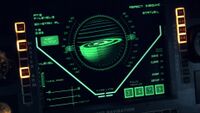
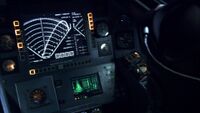
The avionics found on modern Vipers and Raptors are complex systems that combine fly-by-wire technology with computer systems.
In the case of Raptors, datacord is used for networking subsystems. This wiring makes Raptors more radiation-hardened and thus useful in high-radiation conditions [10].
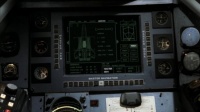
The older and generally-obsolete Viper Mark II fighters have a more primitive avionics package, but unlike CNP-equipped Viper Mark VIIs and Raptors, these old-style Viper systems (a design similar to that used in the Cylon War) appear to combine hydraulics [11] with a basic computer and DRADIS subsystem that is effectively immune from Cylon electronic counterattack.
Both Vipers are equipped with a multi-functional display that can can be set to various modes, such as DRADIS, navigation, engines, system status and weapons.
The flight systems of these systems also likely include these components, which vary in availability or degrees of complexity depending on the craft's age or purpose:
- A non-directional medium-range wireless communications for ship-to-ship and ship-to-planet contact
- DRADIS hardware for enemy targeting, squadron formation flight maneuvers, etc.
- A Colonial transponder for IFF "friend or foe" identification
- Stellar positioning system for proper sublight or FTL navigation
- Larger craft such as Raptors can manage FTL jumps and so come equipped with more advanced avionics to handle jump computations
- Instrument Landing Systems (ILS), an automatic ("hands-off") landing system guidance package

Vulnerabilities[edit]
In the case of modern (pre-holocaust) spacecraft, many of these systems were likely tied into (either as a software or firmware component) the tainted Command Navigation Program. Evidence for this is strong as Jackson Spencer's Mark VII Viper loses power, communications, flight control, DRADIS, and apparently ejection control after Cylon fighters "rooted," or counter-commanded his Viper to shut down, thanks to the backdoors installed in these modern avionics packages (TRS: "Miniseries").
Galactica prohibits computerized landings, so all pilots perform manual approach and landings in non-combat situations. No information has been given in the series if Mark II Vipers are capable of auto-landings in the manner that Mark VIIs demonstrate (TRS: "Miniseries").
Cylon Avionics[edit]
Cylon avionics contain biological elements, some of which include or are interfaced with quasi-sentient elements.
Raiders[edit]
Cylon Raiders contain some level of avionics that co-exist amidst the biological components that form the "pilot" within the fuselage of the fighter. Kara Thrace identifies the mechanical linkage within a captured fighter, and Galen Tyrol's team identifies the fire control, navigation, and FTL drive components in addition to an actual avionics package (TRS: "Flesh and Bone"). Galactica flight crews later rigged a flight control console that mated with the Raider's avionics for human readability.
The Cylons moved to biomechanical pilots rather than using Centurions or other robotic pilot for three probable reasons:
- The Cylons' monotheistic belief in God and their belief in procreation (machines cannot procreate, but living organisms can) suggest that they believe a biological pilot would be more effective. A Raider pilot is programmed with a basic personality akin to a predatory animal. Unlike the logic of a Centurion, a Raider pilot is capable of improvements in its programming--it can learn and anticipate changes in battle ("Six Degrees of Separation," "Scar").
- Colonial forces may attempt to use electronic countermeasures that could affect the performance or operation of a fully-mechanical Cylon Raider or a craft piloted by autonomous Cylon Centurions. Biological pilots cannot be easily disabled by ECM.
- A Raider's personality, like a humanoid Cylon, is downloadable and transferable should the fighter be destroyed. This provides the Cylons a dramatic tactical advantage over the Colonials since the knowledge of a Raider isn't lost in death, allowing it to improve its fighting as well as allowing riskier tactics (such as ramming) without permanent loss of self, provided a Resurrection Ship or the Cylon homeworld is sufficiently close to retrieve a signal (TRS: "Scar").
Raiders are capable of independent thought, which is demonstrated during the Battle of the Ionian Nebula, where one identifies Samuel Anders as a humanoid Cylon. This causes all other Raiders to break off the attack and forces the Cylon fleet to retreat (TRS: "He That Believeth in Me").
Heavy Raider[edit]
The interior of a Heavy Raider, or its cockpit, have not been revealed. While no information is available as to the nature of their avionics and piloting requirements, events suggest that the Heavy Raider is not an autonomous or quasi-autonomous vehicle (Fragged," "The Farm," "Home, Part I") .
Vulnerabilities[edit]
Cylon spacecraft avionics can be affected by infiltration with the right methods. The cooperative Cylon infiltrator copy of Sharon Valerii used herself as a backdoor to send a version of a Cylon virus to shut down power to a massive Cylon fleet en route to attack Galactica (TRS: "Flight of the Phoenix"). It was not shown whether the biologics of the Cylon Raiders are themselves affected by this unexpected infiltration from Valerii.
The organic nature of most Cylon cybernetics is also susceptible to classic human pathogens, which can cause massive and catastrophic system failure. The infection that caused a basestar to succumb (TRS: "Torn"), according to other Cylons investigating the incident, has a bioelectric nature that could cause it to behave more like programming, allowing the downloaded personalities of infected agents to infect the entire Cylon race via the Resurrection Ship.
Computer History[edit]
- For more information on the use of Colonial computers in the series, see Colonial Computer History.
Notes[edit]
- Colonial aesthetics often eschew right angles, instead using octagons. Many computer programs also follow this design by having windows, menus or buttons with angled corners.
References[edit]
- ↑ Podcast: Hero , Act 1.
- ↑ In an amusing props gaffe, fans of the show may notice that the mouse she used is an actual product manufactured by the Microsoft Corporation, which may mistakenly suggest to fans that Microsoft's sales model truly is universal.
- ↑ This is a Battlestar Wiki descriptive term.
- ↑ Sharon "Athena" Agathon instructs a member of the boarding team to place a Colonial data gathering device in one of these pools in "A Measure of Salvation".
- ↑ 5.0 5.1 "The LAN that Time Forgot," Dr. Kevin Grazier (the show's science adviser), BSG Tech Blog, entry 5A, August 8, 2005.
- ↑ One of Gaeta's responsibilities is to monitor DRADIS contacts. To navigate, a battlestar must use some way to determine its location relative to other objects, so the Navigation and DRADIS connection must exist.
- ↑ While Colonel Tigh was on a handset ordering the retraction of the pods as the battlestar began its escape from Ragnar Anchorage, many events within the ship must be coordinated (bulkheads closing, motors for the pod movement activated, etc.) While there was likely a person in CIC or elsewhere that flips a switch or types in a computer command, there must still be a computer used to coordinate these events as they are too many to manage in a limited amount of time (TRS: "Miniseries").
- ↑ Galactica's flak turret guns are seen directly targeting specific missiles during the Battle of Ragnar Anchorage (TRS: "Miniseries").
- ↑ Caprica-Valerii: "Mr. Gaeta, can you set me up with a fiber-optic com link? I need broadcast to all frequencies and direct link to the mainframe." (TRS: "Flight of the Phoenix")
- ↑ Raptors are used as pilot ships in the episode "The Passage".
- ↑ Note the leaking fluid on Viper 289 in the episode "Flight of the Phoenix," strongly suggesting a hydraulic flight control system on these fighters.
